ISSN ONLINE(2319-8753)PRINT(2347-6710)
ISSN ONLINE(2319-8753)PRINT(2347-6710)
S. Savariraj1, T. Ganapathy2, C. G. Saravanan3
|
| Related article at Pubmed, Scholar Google |
Visit for more related articles at International Journal of Innovative Research in Science, Engineering and Technology
The experimental investigation was conducted to evaluate the effect of adding oxygenated additive to fish oil biodiesel (FOBD) blends on a thermal barrier coated DI diesel engine on performance, emission and combustion characteristics. The test fuels are diesel, FOBD of different blending with diesel of 25%,50%, 75% and 100 % and FOBD with 10% V/V additive of 1, 4 dioxane with different blending with diesel of 25 %, 50% , 75% and 100%. Experiment was done in four stages namely, only diesel, diesel with FOBD, diesel with FOBD with additive (FOBD+A) and diesel with FOBD in a Thermal Barrier Ceramic (TBC) coated engine (FOBD+PC). Comparisons were done with different blends namely of 25 %, 50%, 75% and 100%. Maximum Brake Thermal Efficiency (BTE) attains for operating the engine on biodiesel with additive. Coating does not give any effect on BTE. Smoke density for FOBD+A gives less smoke than others for all load and all blends except 100% blend. Smoke density is higher for coated engine than uncoated engine. NOx emission is considerably reduced for TBC coated engine for all blends when compared to FOBD, FOBD+A and diesel. The HC emission is almost same for all blends up to 80% load. The steep increase in HC emission noticed above 80% load. Additive and coating does not give positive effect on HC emission. The peak cylinder pressures of the fish-oil biodiesel and its blends are lower than that of the diesel due to higher brake specific fuel consumption of fish-oil biodiesels. The occurrence of peak cylinder pressures of the fish-oil biodiesels is little earlier than that of diesel
Keywords |
| Fish oil, Bio diesel, ceramic coating, additives. |
I. INTRODUCTION |
| The steep increase of transportation vehicles in the world leads to lavish usage of petroleum fuels. Countries economy is suffered due to heavy usage of fossil fuels. At present Government have a tough challenge on their hands to overcome the import of crude petroleum from the other petroleum oil producing countries. On the other hand the environmental pollutions from the transportation vehicles have a big problem of climate change and acid rain. Hence governments in the world have been focusing on the utilization of renewable energy sources. Utilization of edible and non edible crops for the preparation of alternate source of energy has become common in many researchers. The diesel engines are more efficient than the other standard engine; many researchers found that the BTE of bio diesel operated engine is always less than that of diesel engine. If any engine is said to be reliable then it should develop more BTE, less SFC and less emissions. The Exhaust gas emissions from diesel engine have become serious problem to the researchers. Hence there is a need for finding the solution for reduction of emission from the automobile engines. Among the pollutants, Nitrogen oxide (NOx) and smokes are more harmful to human being. It gives respiratory diseases like lung cancer, bronchitis, etc. |
| NOx is produced in the engine is due to high temperature in combustion chamber. High temperature produced during controlled combustion period leads to the production of NOx. Mechanism to reduce the NOx will increase the smoke emission. It is very difficult to reduce both NOx and smoke simultaneously. The method to reduce the smoke and NOx are |
| •EGR method |
| •Use of high pressure injection system |
| •Exhaust gas treatment |
| •De-NOx catalyst method |
| Many researchers have conducted the experiments in diesel engine to improve the performance and reduce the emissions. One of the useful methods to reduce the NOx is by adding oxygenated additives with diesel fuel. Oxygen available in the additive helps to burn the hydrocarbon available in the fuel leads to the reduction of emission from the exhaust. D.K.Ramesh Rajiv et al., have studied the combustion and emission characteristics of CI engine using fish oil biodiesel blends. The results showed 20 % fish oil biodiesel with diesel blend has improved the performance and exhaust emission. Can cinar et al studied the effect of adding DEE to the bio diesel and compared with neat diesel. They found that the NOx emission decreased up to 19.4 %for adding DEE. |
| Another important concept of lower heat rejection (LHR) from combustion chamber caused an increase in available energy through thermally insulated components. D. Vinay Kumar et.al., investigated the effect of injection pressure on the performance and smoke formation of low heat rejection engine using pongamia methyl ester. Al2O3- TiO2 thermal coated material, coated on the combustion chamber area gives high BTE and decreased the smoke density. The coating in the LHR engine must have high temperature strength, high expansion coefficient, and good shock resistance characteristics. It should have light weight and durability. ZrO2 having excellent coating properties. It has high toughness, high expansion coefficient and high insulation factor. Hence in this study fish oil bio diesel (FOBD) used with 10% additive of 1,4 dioxane and both the mixture was blended with diesel by 25%, 50%, 75% and without diesel. In the second phase of this study, engine piston crown, head and valves were coated with 150μm thickness of ZrO2 and the experiments was conducted with fish oil biodiesel with |
| •Additive of 1, 4 Dioxane |
| •Thermal barrier coating of ZrO2 |
II. EXPERIMENTAL SETUP |
| The experimental setup consists of single cylinder water coated DI diesel engine with 87.5mm bore, 110mm stroke and 17.5:1 compression ratio engine, eddy current dynamometer to apply predetermined loads, emission measurement equipment etc. The engine was coupled with eddy current dynamometer , emission like CO, HC, CO2 and NOx are measured by AVL Digas analyzer, Smoke density was measured by AVL smoke meter. The smoke meter works on light extinction principle. It consists of a flexible sampling hose with appropriate exhaust gas probe. The sampling probe is inserted in the exhaust pipe approximately 200 mm from the engine exhaust. A continuous exhaust sample is passed through the tube of about 46 cm length, which has a light source at one end the other end fitted with a photo cell. The amount of the light passing through the smoke column is sensed as an indication of smoke level. The smoke meter consists of display unit. The smoke density in HSU is displayed. Air flow and fuel flow are measured by monometer and stop watch respectively. The schematic view of the experimental set up is shown figure 1. First the engine was operated with the standard diesel. The emission and performance parameters were recorded after the engine attained steady state condition. The engine coolant water temperature was maintained at 55˚c. The fuel injection pressure was maintained at 205 bar throughout the experiment. The fuel consumption was recorded with manometer and stop watch for 10ml of burette level. The exhaust gas temperature, NOx, HC, CO, CO2 etc are measured by inserting the AVL digas analyzer brobe in the exhaust gas pipe. The smoke density was also recorded by AVL smoke meter. The above parameters and combustion parameter are recorded from each loads at each operating conditions and stored in the computer for post processing of result comparison. |
| Then the experiment was conducted with fish oil biodiesel by changing the fuel supply system. The different blending of fish oil bio diesel of 25%, 50% and 75% with neat diesel and 100% biodiesel test were done. Then the same experimental procedures were repeated for the use of 10% 1, 4 dioxane additives added to the fish oil bio diesel and the same is blended to the diesel in the ratio of 25%, 50%, 75% and 100%. For each fuel change, the engine was allowed to operate for nearly 10min to stabilize at its new desired condition. The same experiment was repeated using FOBD in the LHR ceramic coated engine with the same operating conditions. |
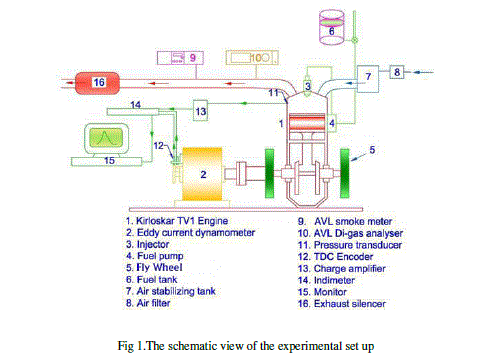 |
| All the performance and emission parameter were measured and recorded and stored in the data acquisition system. The photographic view of the whole experimental setup is shown in figure-2. The measurement system is shown in table-1. |
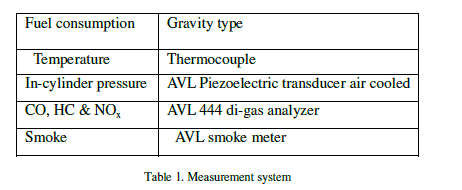 |
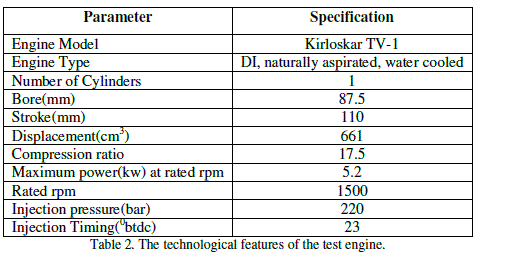 |
III. ADDITIVE, COATING AND EXPERIMENTAL PROCEDURE |
| 1,4 dioxane often called dioxane of 10% V/V was added to the fish oil biodiesel for oxygenation. Dioxane is produced by the acid catalyzed dehydration of diethylene glycol, which is turn arises from the hydrolysis of ethylene oxide. |
| Dioxane has three isomers namely 1, 2-Dioxane, 1, 3-Dioxane and 1, 4-Dioxane are shown in figure 3. |
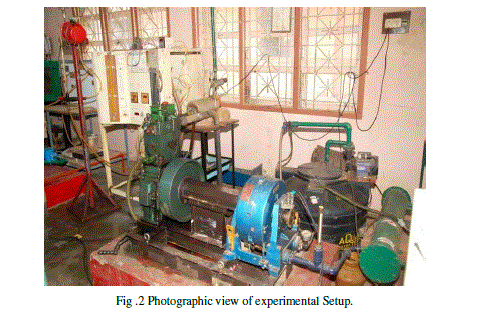 |
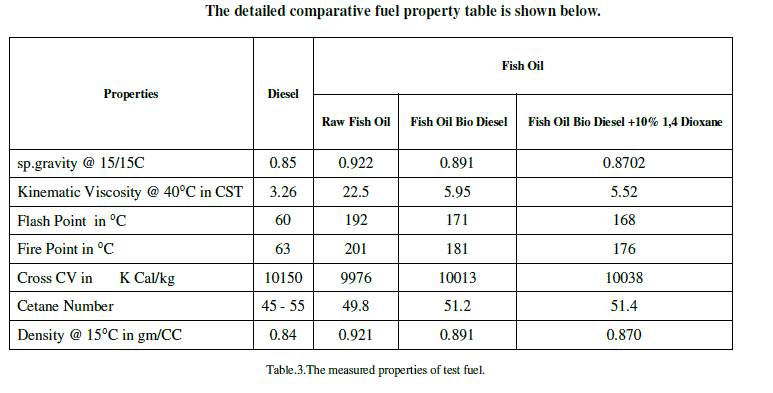 |
IV. PREPARATION OF COATINGS |
| Piston crown, head and values are coated with commercially available ZrO2 and Al2O3 ceramic feed stock powders. The particle size ranging from 38.5 to 36 μm are purchased from dealer sulzer metro. The surfaces to be coated were first grit-blasted using 400 mesh Al2O3 powder. The surface roughness received up to 4Ra. The grit blasted rough surface is then cleaned ultrasonically using anhydrous ethylene alcohol and dioxide in cold air prior to coating. Then ZrO2 coating of 150μm was deposited over the150 μm bond coat of Ni Cr ALY and Al2O3 with a thickness of 150μm was sprayed over the ZrO2 Coating |
| The experiment was conducted in three phases. In the first phase fish oil bio diesel was supplied with different blends of diesel namely 25%, 50%, 75% and 100%. In the second phase 10 % of 1,4 dioxane was added to the FOBD and engine was operated with blends of diesel with 25%, 50%, 75% and 100%. |
| In the third phase, FOBD with different blends of diesel was supplied to the engine with TBC coated piston, head and valves. For each and every fuel change, the engine was allowed to run nearly 10min with a constant speed to attain the steady state condition. The observations were made twice and average value was taken. The parameters measured are CO, CO2, NOx, HC, Smoke, EGT, and SFC & BTE. The comparison of performance & emission characteristics of FOBD, with additive and with coating is discussed here. |
V. RESULT AND DISCUSSION |
A. Comparison of Brake Thermal Efficiency against Brake Power with different blends |
| Variation of BTE with BP for FOBD running, FOBD with coating (FOBD+PC) and with additive (FOBD+A) for 25%, 50%, 75% and 100% blends are shown in fig 3,4,5,6 respectively. Fig.3 shows the comparison of BTE for FOBD, FOB+A and FOBD+PC for 25 blends of FOBD with diesel. When the load increases, BTE is also increase for all the cases. Maximum BTE obtained for FOBD with additive. There are no major changes received for 25% blends. At 50% blends, the BTE of FOBD with additive is higher than diesel. This may be due to good combustion of fuels with its oxygen availability in the additive. |
 |
| The coating of piston does not give any considerable effect a BTE as shown in Fig. 4. Fig.5. shows the variation of BTE with respect to BP of FOBD, FOBD + A and FOBD+PC for 75% blend. BTE for FOBD is higher than diesel but there is no effect on coating and additive for 75% blend. |
| Fig 6. shows the comparative chart of FOBD of 100 % blends. FOBD with additive gives the maximum efficiency at par with other conditions. |
B. Comparison of Smoke density with different blends |
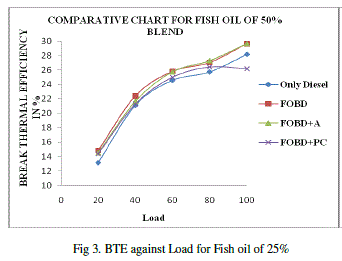 |
| Fig 7, 8, 9 &10 shows the comparative chart of smoke density for FOBD running, FOBD+A and FOBD+PC. The result shows that smoke density for FOBD+A gives less smoke than other for all loads and all blends expect 100% blends. Smoke density is less for only FOBD operation at 100% blends. This may be due to clean burning characteristics of fish oil biodiesel. Coating gives negative effect on smoke density and it is higher for coated engine than ordinary engine. |
C. Comparison of NOx with different blends |
| Fig 11, 12, 13 & 14 shows the comparative charts for variation of Nox for FOBD, FOBD+A & FOBD+PC for 25%, 50%, 75% and 100% blends. |
| The result shows that for all the four blends, the Nox emission is less for piston coated engine when compared to FOBD, FOBD+A and diesel. The main causes in lowering the Nox emission is due to late combustion because of the change in delay period. Bryzik et.al and ramu et.al also found a lower Nox level for a LHR engine compared to the standard engine. |
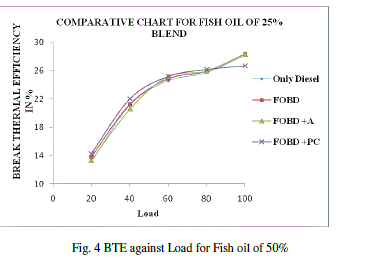 |
| Nox level of FOBD is higher than that of diesel for all the blends. From the comparative chart of Nox level, it is clearly understood that TBC coating gives very good effect on reducing Nox for FOBD. |
D. Comparison of HC with different blends |
| Fig 15, 16, 17 & 18 shows the Comparative chart of variation of HC for FOBD, FOBD+A and FOBD+PC for 25%, 50%, 75% and 100% blend |
| For all the blends, HC emission in almost constant upto 80% load. The steep increase in HC emission is noticed from 80% load to 100% load for all the cases. |
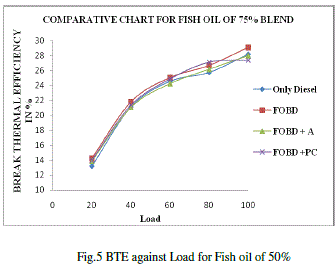 |
| The HC emission is less for diesel than other fuels such as FOBD, FOBD+A and FOBD+PC for all the blends. The addition of fuel additive and coating does not give positive effect on HC emission. |
E. Comparison of Combustion Characteristics with different blends |
| The combustion characteristics of the fish-oil biodiesel and its blends using with additive and with piston coated engine can be analyzed and compared by referring to cylinder pressure-crank angle diagram and heat release rate-crank angle diagram. The cylinder pressure-crank angle diagram for FOBD, FOBD+A, FOBD+PC are shown in figure 19, 20, 21 respectively. To analyze the cylinder pressure, the pressure data of 100 cycles with a resolution of 1°CA was averaged and then used. The cylinder pressure variations for the different fuels, diesel, fish-oil biodiesel and their blends, B25, B50, B75 and B100 are shown in Fig.19. As seen in the figure, the peak cylinder pressures of the fish-oil biodiesel and its blends are lower than that of the diesel due to higher brake specific fuel consumption of fishoil biodiesels. The occurrence of peak cylinder pressures of the fish-oil biodiesels is little earlier than that of diesel. For B25 blend, peak pressure occurs at TDC and for other blends B50, B75 and B100 it occurs at 1° before TDC, while for diesel fuel it occurs at TDC. The oxygen content of the fish-oil biodiesels increases fuel–air mixing rate in the cylinder compared to diesel, and this situation may cause to extend the combustion duration and enhance the combustion efficiency resulting in higher thermal efficiency |
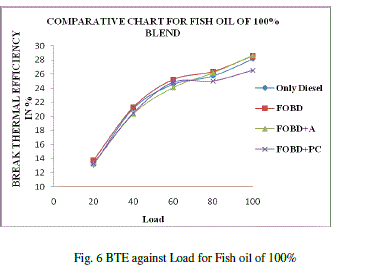 |
| The peak cylinder pressure of the fish-oil biodiesel with an additive of 1, 4 dioxane and its blends are almost equal to diesel but higher than that of operating the engine with only fish oil biodiesel. This may be due to complete combustion and long combustion duration of adding additive. |
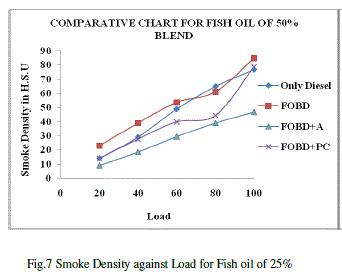 |
| The peak cylinder pressure for fish oil biodiesel and diesel for the ceramic coated engine are less than that of the engine operated with uncoated engine. This may be due to less fuel consumption of fish oil biodiesel in coated engine than uncoated engine. |
| The comparison of heat release rate against crank angle for FOBD, FOBD+A and FOBD+PC are shown in figure-22, 23 and 24 respectively. Heat release calculations provide important information about the combustion process in a diesel engine. The comparison of heat release rate versus crank angle diagrams between different fish-oil biodiesel blends and diesel are shown in Fig. 22 As seen in the figure, the starts of combustion (SOC) timing for fishoil biodiesels and blends are little earlier than diesel due to their earlier start of injection timings. The SOC timing of the B25, B50, B75 and B100 was taken place at 16°CA before TDC, while the SOC timing in the case of diesel was occurring at 15°CA before TDC. This value shows that the SOC timing with the use of the biodiesels advanced more than 1°CA compared to diesel. The premixed combustion phase for all blends of fish-oil biodiesels was found longer than that of diesel. This situation can be explained with the vaporization of fish-oil biodiesel which is more slowly than diesel and contributes less premixed combustion. However, its oxygen content affects SOC timing. |
| When the additives are added to the fish oil biodiesel, the heat release rate is increased. The oxygen present in the additive enhances fuel to burn rapidly during the premixed combustion phase which is shown in figure 23. |
| The figure 24.shows the heat release rate against crank angle diagram for fish oil biodiesel operated in a ceramic coated engine. The heat release rate to the combustion chamber is highly reduced for ceramic coated engine. The combustion characteristics of FOBD and diesel are almost same when the engine combustion areas are coated. |
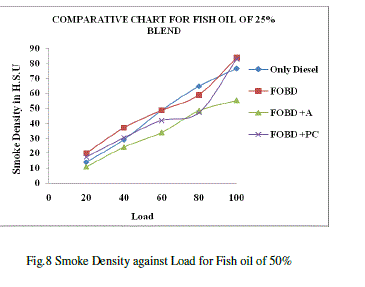 |
VI. CONCLUSION |
| This paper experimentally studies for performance, emission and combustion characteristics of direct injection diesel engine used with different blends of fish oil biodiesel, the addition of 1,4 dioxane on FOBD, and with piston coated engine. The conclusions of this study are as follows. |
| The comparison of brake thermal efficiency is done for FOBD, FOBD+A and FOBD+PC for 25%, 50% &75% and 100% blends. The maximum BTE is achieved for fish oil biodiesel fuels with 10% additive for 25% & 50%blend. |
| •Coating on the piston does not give any appreciable effect on BTE. |
| •FOBD+A gives less smoke than others for all loads and all blends except 100 % blends. |
| •NOx emission is considerably reduced for piston coated (TBC) engine |
| •Additive and coating does not give any positive effect on HC emission. |
| From the above study, it is clear that the fish oil biodiesel with 10% fuel additive used in the Thermal Barrier Coated engine releases less smoke as well as less NOx. Additive added fish oil biodiesel upto 50% blend can be used for getting better Brake Thermal Efficiency. |
| The starts of combustion (SOC) timing for fish-oil biodiesels and blends are little earlier than diesel due to their earlier start of injection timings. The SOC timing of the B25, B50, B75 and B100 was taken place at 16°CA before TDC, while the SOC timing in the case of diesel was occurring at 15°CA before TDC. This value shows that the SOC timing with the use of the biodiesels advanced more than 1°CA compared to diesel. |
| When the additives are added to the fish oil biodiesel, the heat release rate is increased The heat release rate to the combustion chamber is highly reduced for ceramic coated engine. The combustion characteristics of FOBD and diesel are almost same when the engine combustion areas are coated. The above comparative study clearly reveals that possibility of using the bio diesel with additive in the ceramic coated DI diesel engines. The combustion, performance and emission characteristics show the suitability of fish oil bio diesel in LHR engine. |
ACKNOWLEDGEMENT |
| The Author would like to thank the Annamalai University Faculty of Engineering and Technology authorities for having given permission to do the experimental work. |
References |
|